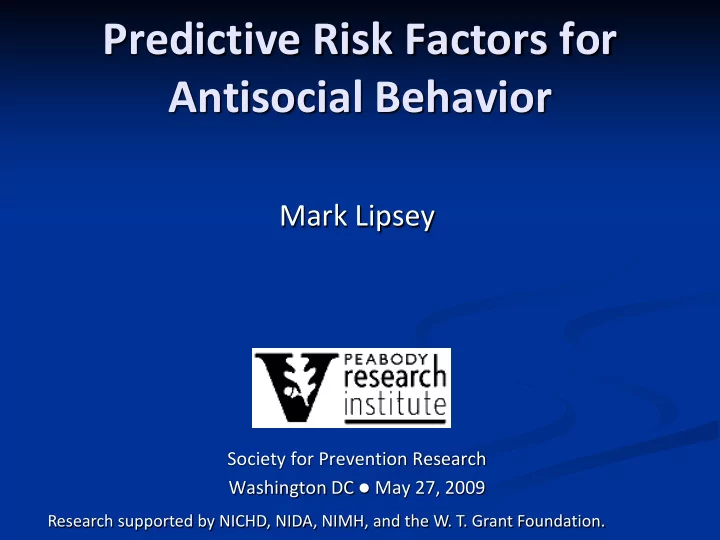

Predictive Risk Factors for Antisocial Behavior Mark Lipsey Society for Prevention Research Washington DC May 27, 2009 Research supported by NICHD, NIDA, NIMH, and the W. T. Grant Foundation.
Data available from the meta-analysis 225 studies reporting 11,388 longitudinal correlations between a risk variable and an antisocial behavior variable measured later Sample characteristics 67% primarily white, 18% primarily minority 47% primarily low/working class, 24% primarily middle class Mean proportion male = .57 Mean age at first wave = 10.1 Mean interval between waves = 32 mos. Major sources for the risk and outcome measures Child reports: 43% or the risk measures and 38% of the outcome measures Teacher reports: 11% of the risk measures and 24% of the outcome measures
Identifying the construct categories for antisocial behavior outcomes Antisocial behavior (ASB) measures inductively sorted into categories based on conceptual similarity MR models used to standardize cross-sectional correlations between different ASB measures for a consistent profile of sample and measurement characteristics Age, gender, SES, ethnicity, risk Source (child, parent, etc.), scaling (binary, continuous) Mean cross-sectional correlations across constructs examined to ensure that inclusion in the same construct category is empirically justified
Antisocial behavior outcome constructs Mean Mean cross- cross- Constructs & construct construct Constructs & construct construct categories correlation categories correlation Delinquency/ Illegal Behavior .30 Problem Behavior Aggression & disruption .33 Violence/Aggression Disruptive behavior .34 Violence .41 School adjustment .33 Aggressive behavior .32 Anger, hostility .35 CBCL delinquency .29
Number of Longitudinal Correlations in Major Risk Categories Predicting Antisocial Behavior Outcomes Antisocial Behavior Outcome Delinquency/ Risk Variable Category Illegal Violence/ Problem Behavior Aggression Behavior Prior antisocial behavior 793 559 1974 Substance use 154 62 28 Drug exposure & attitudes 185 49 28 School motivation & attitudes 320 84 386 Peer behavior & influences 343 90 35 Parenting behaviors 647 207 1264
Adjustments to the longitudinal correlation coefficients Step 1: MR models used to produce standardized longitudinal correlation coefficients for a consistent profile of measurement characteristics: Scaling (e.g., dichotomous, continuous) Reporting source (e.g., self vs. parent) Form of data collection (e.g., standardized test, observation) Step 2: Second stage MR models used to predict the standardized correlation coefficients from age, age 2 , interval between waves, and age*interval for each combination of risk-outcome categories Risk-outcome correlations for given Time 1 and Time 2 ages estimated from the second stage models
Mean correlations between major risk categories at age 11 and ASB outcomes at 16 Antisocial Behavior Outcome Delinquency/ Risk Construct Category Illegal Violence/ Problem Behavior Aggression Behavior Prior antisocial behavior .32 .73 .19 Substance use .54 .48 .27 Drug exposure & attitudes .17 .12 .19 School motivation & attitudes .33 .33 .34 Peer behaviors & influences .18 .35 .37 Parenting behaviors .18 .22 .40 a Estimated from weighted regression models that included age at Time 1, age 2 , Time 1-Time 2 interval, and age*interval; means calculated from the models for age= 11 and interval= 5 (age 16).
Within a risk category, micro constructs have about the same risk-outcome correlations: E.g., Prior ASB and SU as predictors of Delinquency/Illegal Behavior T1=11 T1=16 T2=16 T2=20 Nes (Nss) Risk Constructs & Categories Prior Antisocial Behavior Delinquency/illegal behavior .33 .31 479 (106) Violence/aggression .30 .29 62 (15) Low level problem behavior .30 .29 188 (48) Substance Use Alcohol use .56 .28 51 (12) Marijuana use .55 .27 41 (6) Mixed substance use .51 .22 60 (14)
Risk age differences: For prior ASB, risk at later age is stronger predictor of delinquency Prior ASB predicting delinquency at age 18 1.00 0.90 0.80 Risk-Outcome 0.70 Correlation 0.60 0.50 0.40 0.30 0.20 0.10 0.00 6 8 10 12 14 16 Age at T1
Peer influence at later ages is a stronger predictor of delinquency Peer behavior/ influences predicting delinquency at age 18 1.00 0.80 Risk-Outcome 0.60 Correlation 0.40 0.20 0.00 8 10 12 14 16 -0.20 -0.40 Age at T1
Substance use at earlier ages is a stronger predictor of delinquency Substance use predicting delinquency at age 18 1.00 0.90 Risk-Outcome 0.80 Correlation 0.70 0.60 0.50 0.40 0.30 0.20 0.10 0.00 10 12 14 16 Age at T1
Parenting at earlier ages is a stronger predictor of delinquency Parenting practices predicting delinquency at age 18 1.00 0.90 Risk-Outcome 0.80 Correlation 0.70 0.60 0.50 0.40 0.30 0.20 0.10 0.00 6 8 10 12 14 16 Age at T1
Recommend
More recommend